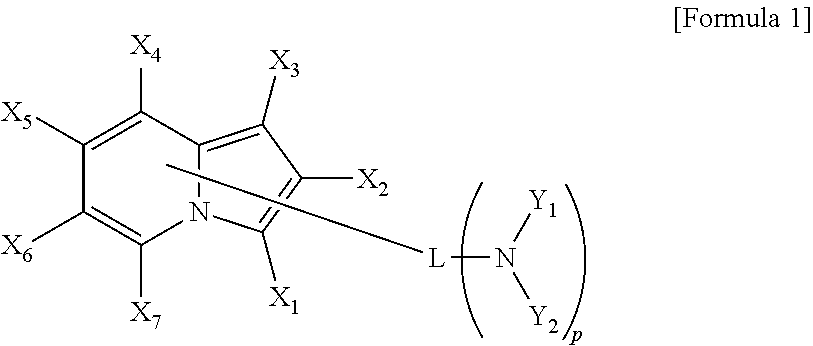New heterocyclic derivative and organic light emitting device using same
a heterocyclic derivative and light-emitting device technology, applied in the direction of discharge tube/lamp details, discharge tube luminescnet screens, organic chemistry, etc., can solve the problems of difficult to produce an organic light-emitting device with high efficiency and a long life span, and the difficulty of being applied to an organic light-emitting device requiring a high current, so as to improve the life span property of the device, reduce the driving voltage of the device, and improve the effect of light-
- Summary
- Abstract
- Description
- Claims
- Application Information
AI Technical Summary
Benefits of technology
Problems solved by technology
Method used
Image
Examples
example
Preparation Example 1
Preparation of the compound represented by Formula 1-1
[0060]
[0061]1) Preparation of Formula 1A
[0062]2-bromoacetophenone (25.4 g, 127.6 mmol), and 2-picoline (11.9 g, 127.6 mmol) were put into 150 ml of toluene, and refluxed under the nitrogen atmosphere for 3 hours. The product generated after being cooled to room temperature was filtered. The filtered product was agitated in K2CO3 (aq) at 80° C. The product generated after being cooled to room temperature was filtered and dried to obtain Formula 1A (20.3 g, yield 82%).
[0063]MS: [M+H]+=194
[0064]2) Preparation of Formula 1B
[0065]Formula 1A (5.0 g, 25.87 mmol), and 1-bromo-4-chlorobenzene (5.94 g, 31.05 mmol) were dissolved in 100 ml of NMP, H2O 1 ml, KOAc (5.0 g, 51.74 mmol), and PdCl2 (PPh3)2 (0.95 g, 1.29 mmol) were added thereto, and refluxed for 5 hours under the nitrogen atmosphere. Distilled water was put into the reaction solution, the termination of the reaction was carried out, and the organic layer was ...
preparation example 2
Preparation of the Compound Represented by Formula 1-2
[0070]Formula 1B (7.5 g, 24.69 mmol), and N-biphenyl-1-naphtylamine (8.0 g, 27.15 mmol) were dissolved in 150 ml of xylene, sodium-tertiary-botoxide (3.56 g, 37 mmol), and Pd[P(t-Bu)3]2 (0.13 g, 0.247 mmol) were added thereto, and refluxed for 5 hours under the nitrogen atmosphere. Distilled water was put into the reaction solution, the termination of the reaction was carried out, and the organic layer was extracted. After the column separation was carried out with normal-hexane / tetrahydrofurane=10 / 1 solvent, it was agitated in petroleum ether, and dried under vacuum to manufacture Formula 1-2 (6.8 g, yield 49%).
[0071]MS: [M+H]+=563
preparation example 3
Preparation of the Compound Represented by Formula 1-3
[0072]Formula 1B (7.5 g, 24.69 mmol), and bisbiphenylamine (8.73 g, 27.15 mmol) were dissolved in 150 ml of xylene, sodium-tertiary-botoxide (3.56 g, 37 mmol), and Pd[P(t-Bu)3]2 (0.13 g, 0.247 mmol) were added thereto, and refluxed for 5 hours under the nitrogen atmosphere. Distilled water was put into the reaction solution, the termination of the reaction was carried out, and the organic layer was extracted. After the column separation was carried out with normal-hexane / tetrahydrofurane=10 / 1 solvent, it was agitated in petroleum ether, and dried under vacuum to manufacture Formula 1-3 (7.3 g, yield 44%).
[0073]MS: [M+H]+=665
PUM
| Property | Measurement | Unit |
|---|---|---|
| glass transition temperature | aaaaa | aaaaa |
| temperature | aaaaa | aaaaa |
| structures | aaaaa | aaaaa |
Abstract
Description
Claims
Application Information
 Login to View More
Login to View More - R&D
- Intellectual Property
- Life Sciences
- Materials
- Tech Scout
- Unparalleled Data Quality
- Higher Quality Content
- 60% Fewer Hallucinations
Browse by: Latest US Patents, China's latest patents, Technical Efficacy Thesaurus, Application Domain, Technology Topic, Popular Technical Reports.
© 2025 PatSnap. All rights reserved.Legal|Privacy policy|Modern Slavery Act Transparency Statement|Sitemap|About US| Contact US: help@patsnap.com



